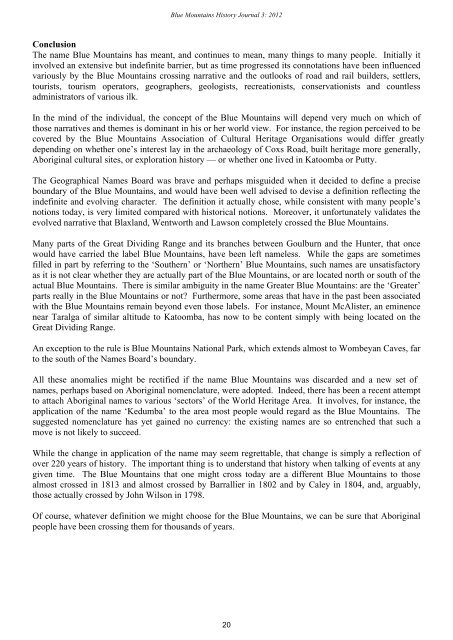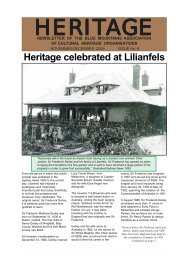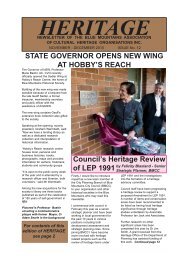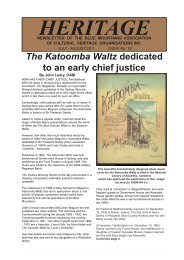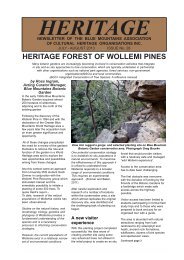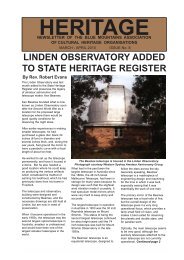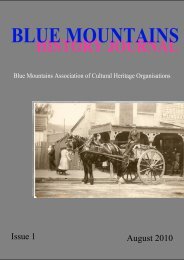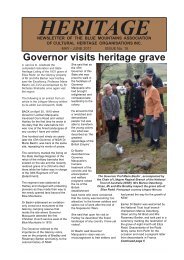Blue Mountains History Journal Issue 3
Blue Mountains History Journal Issue 3
Blue Mountains History Journal Issue 3
Create successful ePaper yourself
Turn your PDF publications into a flip-book with our unique Google optimized e-Paper software.
<strong>Blue</strong> <strong>Mountains</strong> <strong>History</strong> <strong>Journal</strong> 3: 2012<br />
Conclusion<br />
The name <strong>Blue</strong> <strong>Mountains</strong> has meant, and continues to mean, many things to many people. Initially it<br />
involved an extensive but indefinite barrier, but as time progressed its connotations have been influenced<br />
variously by the <strong>Blue</strong> <strong>Mountains</strong> crossing narrative and the outlooks of road and rail builders, settlers,<br />
tourists, tourism operators, geographers, geologists, recreationists, conservationists and countless<br />
administrators of various ilk.<br />
In the mind of the individual, the concept of the <strong>Blue</strong> <strong>Mountains</strong> will depend very much on which of<br />
those narratives and themes is dominant in his or her world view. For instance, the region perceived to be<br />
covered by the <strong>Blue</strong> <strong>Mountains</strong> Association of Cultural Heritage Organisations would differ greatly<br />
depending on whether one’s interest lay in the archaeology of Coxs Road, built heritage more generally,<br />
Aboriginal cultural sites, or exploration history — or whether one lived in Katoomba or Putty.<br />
The Geographical Names Board was brave and perhaps misguided when it decided to define a precise<br />
boundary of the <strong>Blue</strong> <strong>Mountains</strong>, and would have been well advised to devise a definition reflecting the<br />
indefinite and evolving character. The definition it actually chose, while consistent with many people’s<br />
notions today, is very limited compared with historical notions. Moreover, it unfortunately validates the<br />
evolved narrative that Blaxland, Wentworth and Lawson completely crossed the <strong>Blue</strong> <strong>Mountains</strong>.<br />
Many parts of the Great Dividing Range and its branches between Goulburn and the Hunter, that once<br />
would have carried the label <strong>Blue</strong> <strong>Mountains</strong>, have been left nameless. While the gaps are sometimes<br />
filled in part by referring to the ‘Southern’ or ‘Northern’ <strong>Blue</strong> <strong>Mountains</strong>, such names are unsatisfactory<br />
as it is not clear whether they are actually part of the <strong>Blue</strong> <strong>Mountains</strong>, or are located north or south of the<br />
actual <strong>Blue</strong> <strong>Mountains</strong>. There is similar ambiguity in the name Greater <strong>Blue</strong> <strong>Mountains</strong>: are the ‘Greater’<br />
parts really in the <strong>Blue</strong> <strong>Mountains</strong> or not? Furthermore, some areas that have in the past been associated<br />
with the <strong>Blue</strong> <strong>Mountains</strong> remain beyond even those labels. For instance, Mount McAlister, an eminence<br />
near Taralga of similar altitude to Katoomba, has now to be content simply with being located on the<br />
Great Dividing Range.<br />
An exception to the rule is <strong>Blue</strong> <strong>Mountains</strong> National Park, which extends almost to Wombeyan Caves, far<br />
to the south of the Names Board’s boundary.<br />
All these anomalies might be rectified if the name <strong>Blue</strong> <strong>Mountains</strong> was discarded and a new set of<br />
names, perhaps based on Aboriginal nomenclature, were adopted. Indeed, there has been a recent attempt<br />
to attach Aboriginal names to various ‘sectors’ of the World Heritage Area. It involves, for instance, the<br />
application of the name ‘Kedumba’ to the area most people would regard as the <strong>Blue</strong> <strong>Mountains</strong>. The<br />
suggested nomenclature has yet gained no currency: the existing names are so entrenched that such a<br />
move is not likely to succeed.<br />
While the change in application of the name may seem regrettable, that change is simply a reflection of<br />
over 220 years of history. The important thing is to understand that history when talking of events at any<br />
given time. The <strong>Blue</strong> <strong>Mountains</strong> that one might cross today are a different <strong>Blue</strong> <strong>Mountains</strong> to those<br />
almost crossed in 1813 and almost crossed by Barrallier in 1802 and by Caley in 1804, and, arguably,<br />
those actually crossed by John Wilson in 1798.<br />
Of course, whatever definition we might choose for the <strong>Blue</strong> <strong>Mountains</strong>, we can be sure that Aboriginal<br />
people have been crossing them for thousands of years.<br />
20


